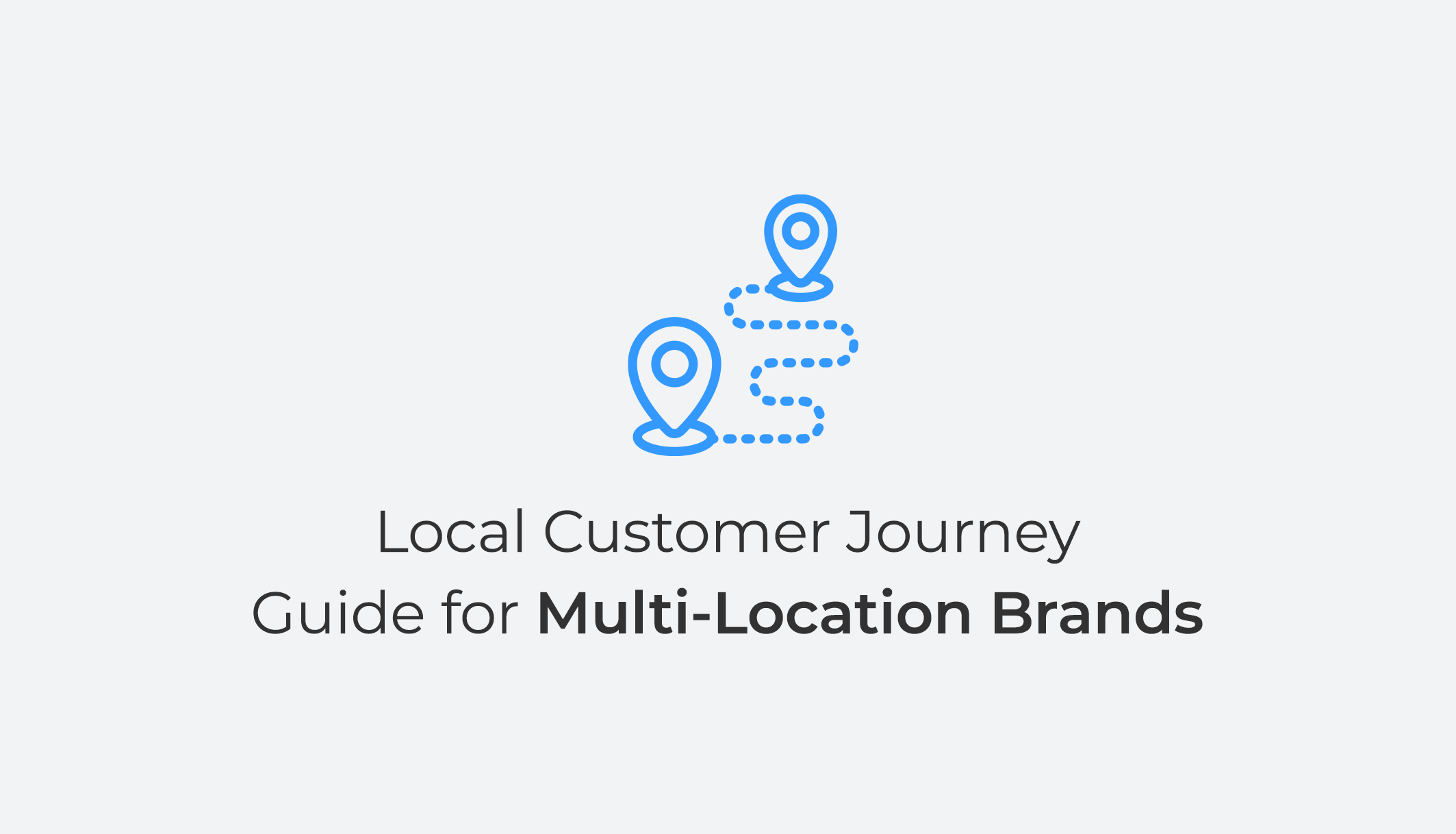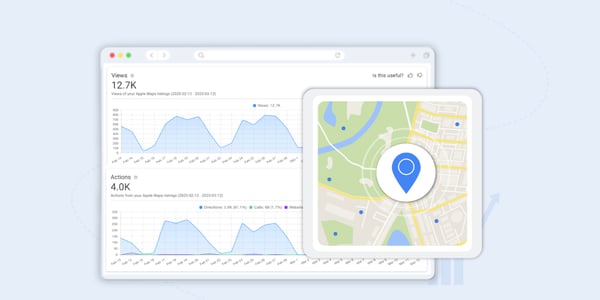Today's technologically advanced world makes it imperative for multi-location brands to have a strong online presence and make efficient use of digital opportunities. From online search to in-store experience, understanding each step of the journey and implementing effective strategies can decide brand visibility, foot traffic, and overall business performance. This guide will take you through the local customer journey step by step, providing insights and actionable tips for boosting your multi-location brand's online visibility and ultimately driving more foot traffic.

STAGE 1 - Discovery: Making Your Location Easy to Find
This is where potential customers become aware of your brand as they search for your business in online channels. To make your locations easily discoverable:
1. Optimise your website and local landing pages for search engines, focusing on relevant keywords, quality content, and mobile-friendliness. Explore our 6-step guide on how to create local landing pages that convert.
2. Keep your business listings up to date on platforms like Google Business Profile, Apple Maps, and Bing Places.
3. Invest in targeted online advertising, such as search engine marketing (SEM) and social media ads, to reach your desired audience.
4. Create engaging and shareable content on your website, blog, and social media platforms to increase brand exposure and drive organic traffic.
Learn how to reach your fullest GBP potential in our Complete Google Business Profile Guide.
STAGE 2 - Comparison: Establishing Trust and Credibility
Once potential customers have discovered your brand online, they typically engage in research and comparison. To stand out from competitors and build trust:
1. Showcase positive customer reviews and ratings on your website, local landing pages, and social media profiles. Monitor online reviews effectively and answer both negative and positive ones to show that you value your customers’ feedback. 92% of users will use a local business if it has at least a 4-star rating.
2. Develop location-specific content to demonstrate your brand's understanding of the local market, culture, and customer preferences.
3. Offer clear and transparent information about your products, services, pricing, and location-specific promotions.
4. Encourage satisfied customers to share their experiences and recommendations through word-of-mouth marketing or online reviews.
STAGE 3 - Engagement: Building Relationships and Loyalty
After researching, customers will request directions to your store or call for more information. During the engagement stage, customers interact with your brand and develop a deeper interest in your offerings. To nurture good customer relationships and loyalty:
1. Respond promptly and professionally to customer inquiries, comments, or concerns on your website, social media profiles, or review platforms.
2. Provide personalised experiences based on customer data, such as browsing history, past purchases, and demographics.
3. Implement a user-friendly website design and seamless navigation to encourage longer browsing sessions and lower bounce rates.
4. Offer valuable and relevant content like how-to guides, industry insights, or behind-the-scenes looks at your business operations, to keep your audience engaged and informed.
STAGE 4 - Decision: Turning Online Visitors into In-Store Customers
At the decision stage, customers choose to visit one of your physical locations. This is the time when you want to make sure that all questions are answered and your business value is well-positioned. To convert online visitors into in-store customers:
1. Ensure your website and local landing pages and listings contain accurate and up-to-date information about store hours, locations, and inventory.
*Google found that 76% of people who search for something nearby on their smartphones visit a related business within a day.
2. Offer convenient online tools, such as store locators, real-time inventory updates, or click-and-collect services.
3. Provide incentives for store visits, such as exclusive in-store promotions, discounts, or events.
4. Make it easy for customers to book appointments, make reservations, or request additional information through your website, app, or chatbot.
Streamlining Management of Multiple Locations
Multi-location brands often have a more difficult and time-consuming time managing their online presence, reputation, and customer experience. Yet it is possible to boost both brand awareness and customer traffic with the help of the right tools and tactics. PinMeTo offers a comprehensive location marketing platform designed to help multi-location brands simplify and streamline the entire process. With PinMeTo you can:- Bulk claim & verify listing profiles as well as automate updates in Google Maps, Apple Maps, and more than 100 search services.
- Manage and update your business listings across multiple platforms, ensuring that your information is accurate and consistent.
- Monitor and respond to customer reviews, ratings, and inquiries across different review platforms and social media networks.
- Get insights about each of your locations direction clicks, map views and learn ways on optimising your listings for local search.
STAGE 5 - In-Store Experience: Creating Positive Interactions
1. Educate your staff to provide exceptional customer service, personalised recommendations, and assistance.
2. Design an inviting and visually appealing store layout that encourages exploration and discovery.
3. Try out innovative technologies, such as augmented reality or interactive displays, to create immersive experiences and differentiate your brand from competitors.
4. Make sure you have consistent branding and messaging across all locations, both online and offline so that you create a smooth customer experience.
STAGE 6 - Post-Purchase: Encouraging Brand Advocacy
After completing the in-store experience, customers can become valuable brand ambassadors by sharing their positive experiences and recommending your brand to others. To encourage post-purchase advocacy:
1. Develop an attractive customer loyalty program that rewards customers for their purchases, referrals, or other actions, and make it easy for them to redeem rewards at any of your locations.
2. Proactively seek customer feedback and reviews, both online and offline, to identify areas of improvement and demonstrate your commitment to customer satisfaction.
*88% of consumers trust online reviews as much as personal recommendations.
3. Leverage user-generated content (UGC), such as customer photos, videos, or reviews, to showcase real-life experiences and build trust with potential customers.
4. Engage with customers on social media platforms, thanking them for their support, responding to their questions, or sharing their content.
Analysing and Optimising the Customer Journey
To get the most out of your online presence and foot traffic, it's important to analyse and improve the customer journey based on performance data and customer feedback on a regular basis. Here are some tactics for continuous improvement:Map Local Keywords
Map your keywords based on your customers’ search intent by breaking down your customers’ motivation at the moment of search into 4 main stages of Informational, Navigational, Transactional, and Conversional search intents. Dedicate tailored content and keywords to for each stage of the customer journey.
Track Progress
Monitor KPIs related to the customer journey and foot traffic like store visits, dwell time, conversion rate, and average transaction value and use this data to identify patterns, trends, and areas of improvement.
Talk to Your Clients
Conduct regular customer surveys or focus groups to gather feedback on your brand's online and in-store experiences. This feedback can help you identify pain points and uncover opportunities for improvement.
Explore and Experiment
Try out different strategies, such as website design, content types, or promotional offers, to determine which approaches are most effective in driving foot traffic and customer satisfaction.
Stay Current
Keep your team up-to-date with industry trends, emerging technologies, and competitor activities to ensure your brand remains relevant and competitive in the ever-changing digital landscape. Regularly attending industry events and subscribing to relevant publications can help you stay informed.
To Sum Up
Navigating the modern local customer journey for multi-location brands often asks for a deep understanding of each stage, from online search to in-store experience, and a commitment to continuous improvement. By implementing the strategies outlined in this guide, you can increase your multi-location brand’s online visibility, drive foot traffic, and create memorable customer experiences that foster loyalty and advocacy. By focusing on discovery, research and comparison, engagement, decision-making, in-store experience, and post-purchase advocacy, you can effectively attract and retain customers, ultimately leading to increased revenue and long-term success.
Looking for ways to level up your local visibility?
Give us an overview about your business below and we'll prepare a free local visibility audit
Lily Adamyan, April 26



